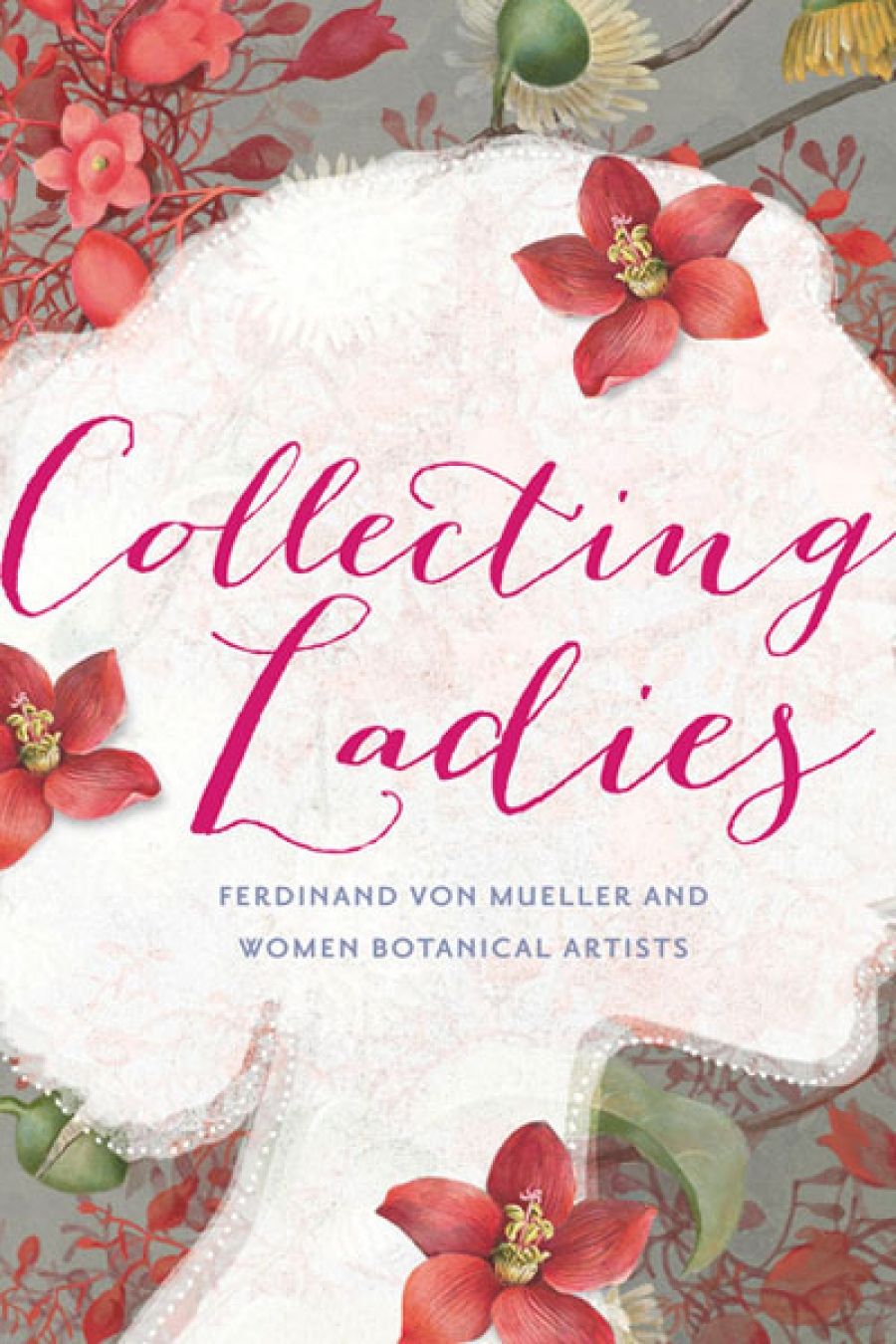
- Free Article: No
- Contents Category: Art
- Custom Article Title: Simon Caterson reviews 'Collecting Ladies' by Penny Olsen
- Review Article: Yes
- Article Title: Adornments
- Online Only: No
- Custom Highlight Text:
We are used to modern science being conducted as a collaborative effort involving teams of researchers in laboratories, but imagine a huge research project requiring thousands of researchers and covering every corner of an entire continent (and beyond) being organised successfully with no telephone or Internet.
- Book 1 Title: Collecting Ladies
- Book 1 Subtitle: Ferdinand von Mueller and Women Botanical Artists
- Book 1 Biblio: National Library of Australia, $39.99 pb, 247 pp, 9780642277534
The task of identifying all of Australia’s flora was a massive undertaking in primary data collection whose chief organiser was Baron Sir Ferdinand von Mueller (1825–1896). A German émigré based in Melbourne, where for many years he was the director of the Royal Botanic Gardens, Mueller’s achievements and vivid personality still feature prominently in the annals of Australian science, and he is perhaps the only Australian botanist to have inspired an opera. As Penny Olsen notes, Mueller had an astonishing capacity for work:
He was not the first to light upon this method of gathering material from a large area – it was standard practice among his colleagues in Europe. However, he must have assembled the largest network on any continent – approaching 3,000 known collectors – and maintained it by a phenomenal body of correspondence to them and to scientists all around the world. By his own count he wrote between 2,000 and 6,000 letters a year, nearly all personally.
Among the many far-flung contributors who supplied material for Mueller was a substantial number of highly skilled women botanical artists. With a few of them at least, Mueller seems to have developed a complex relationship that went beyond the purely professional. That emotional complexity is captured in the double meaning of the book’s title and may allude to the erotic charge that surely has the potential to run through any meeting of minds.
It should be pointed out that Mueller was not a libertine. His immense workload meant he scarcely had time to dally, and, in any case, he was notorious for not bathing, ostensibly for fear of contracting tuberculosis. Mueller did, however, propose marriage to Euphemia Henderson, one of the women artists included in Collecting Ladies, and was accepted by her, though the proposal was later withdrawn. (Euphemia proved to be remarkably forgiving.)
The débâcle of the withdrawn marriage proposal was the kind of emotional mess that Mueller was apt to make for himself. He never married and died childless, but never ceased to long, apparently, for an heir to the baronetcy he had been granted.
As Olsen relates, the women artists themselves did not have it easy either, their struggle, however, was of a rather different nature from Mueller’s failure to marry. The role that a woman could take in advancing science, or indeed in professional life, was limited:
A polite interest in botany was a traditionally feminine pursuit so that collecting and pressing plants for the great botanist was a welcome extension – a chance to contribute to a grand project, to scientific knowledge, and to engage with the wider world. Women were still not welcome at the cutting edge of science – preserved for the time being for men – where plants could be described and named and spoken about at professional societies.
It was this frustration that led Harriet Scott, one of the artists featured in Collecting Ladies, to complain in a letter to the ornithologist Edward Ramsay, who was a family friend, that her gender confined her to domesticity and that, ‘if only I were a man I might go writing books or getting a name in some profession, or turn politician or a hundred other things – clearly I ought to have been Harry Scott instead of Hattie Scott’.
Olsen profiles fourteen women artists. Their work is handsomely represented, and much of it is very fine indeed. One artist the quality of whose work was recognised as going beyond mere scientific illustration and who actually did win prizes for her art was Ellis Rowan. Her success in winning a prize for painting at the Melbourne International Exhibition of 1880 provoked a jealous response from certain male painters, according to Olsen.
It was all too much for the ‘professional’ male art establishment whose works had been all but snubbed. The likes of Tom Roberts complained that Rowan was a dauber of pretty flowers, not ‘real art’, and Norman Lindsay, who painted saucy nudes, had the temerity to comment: ‘Well, her works are so vulgar.’ Despite the furore, the large panel of international judges stuck to their choice.
As well as challenging wherever possible the social constraints placed on them because of their gender, Olsen’s women botanical artists also displayed an early awareness of environmental issues. More than one is quoted by Olsen as deprecating the widespread land clearing that was going on, not just on aesthetic grounds but also because it laid waste to an entire ecosystem. ‘It would seem,’ Louisa Atkinson perceived, ‘that the forests have acted as safety valves.’
‘Together,’ Olsen sums up, ‘these ladies produced some of the most beautiful books and botanical art to come out of Australia in the nineteenth century, covering all the Australian colonies.’ My own favourite among the portraits is that of Atkinson, a novelist as well as naturalist who chose to specialise in non-flowering plants such as ferns, precisely because they were not brightly coloured and therefore not an obvious choice. Moved, as were so many of the botanical artists of the era, by a deep religious conviction in their appreciation of the natural world, Atkinson wrote that she admired ferns because flowerless plants reminded her that ‘beauty when unadorned is adorned the most’.


Comments powered by CComment